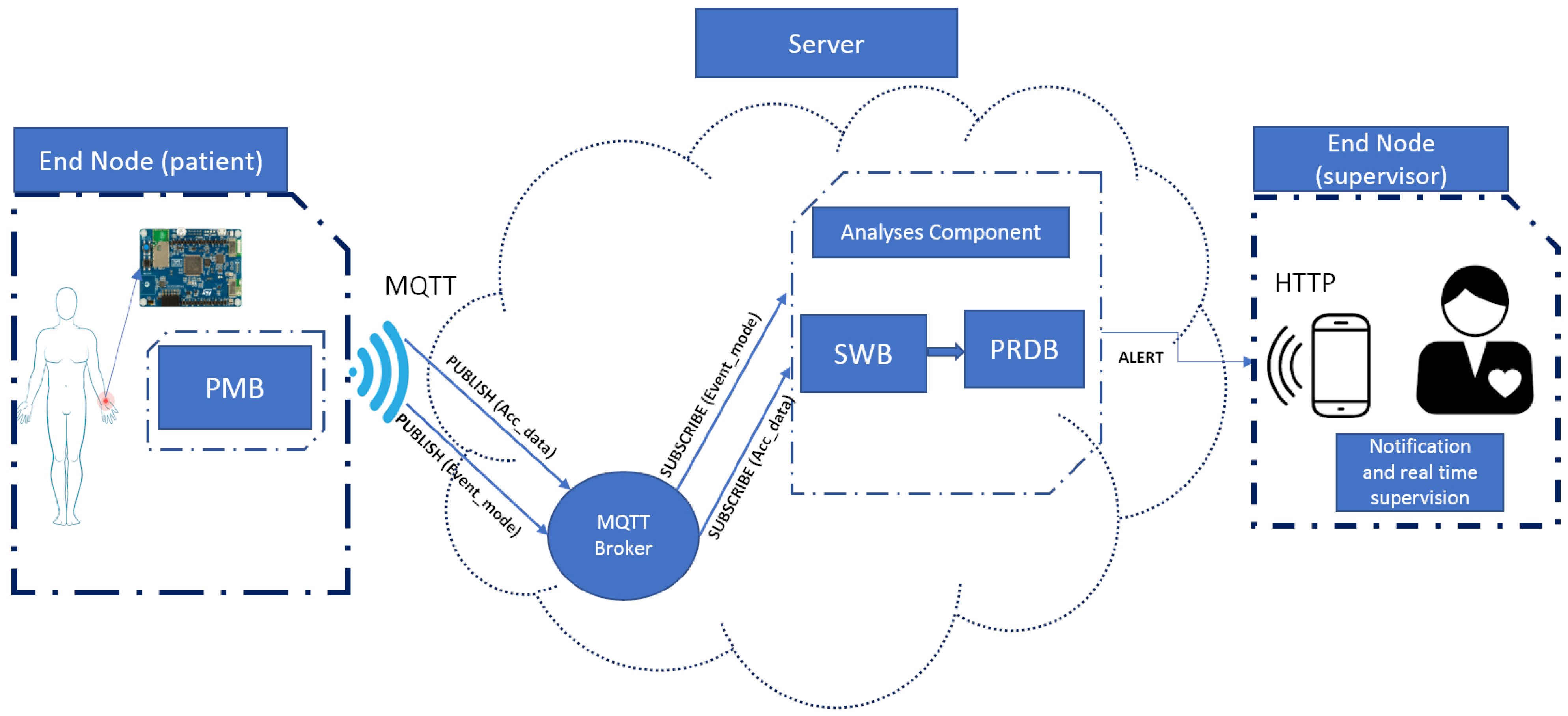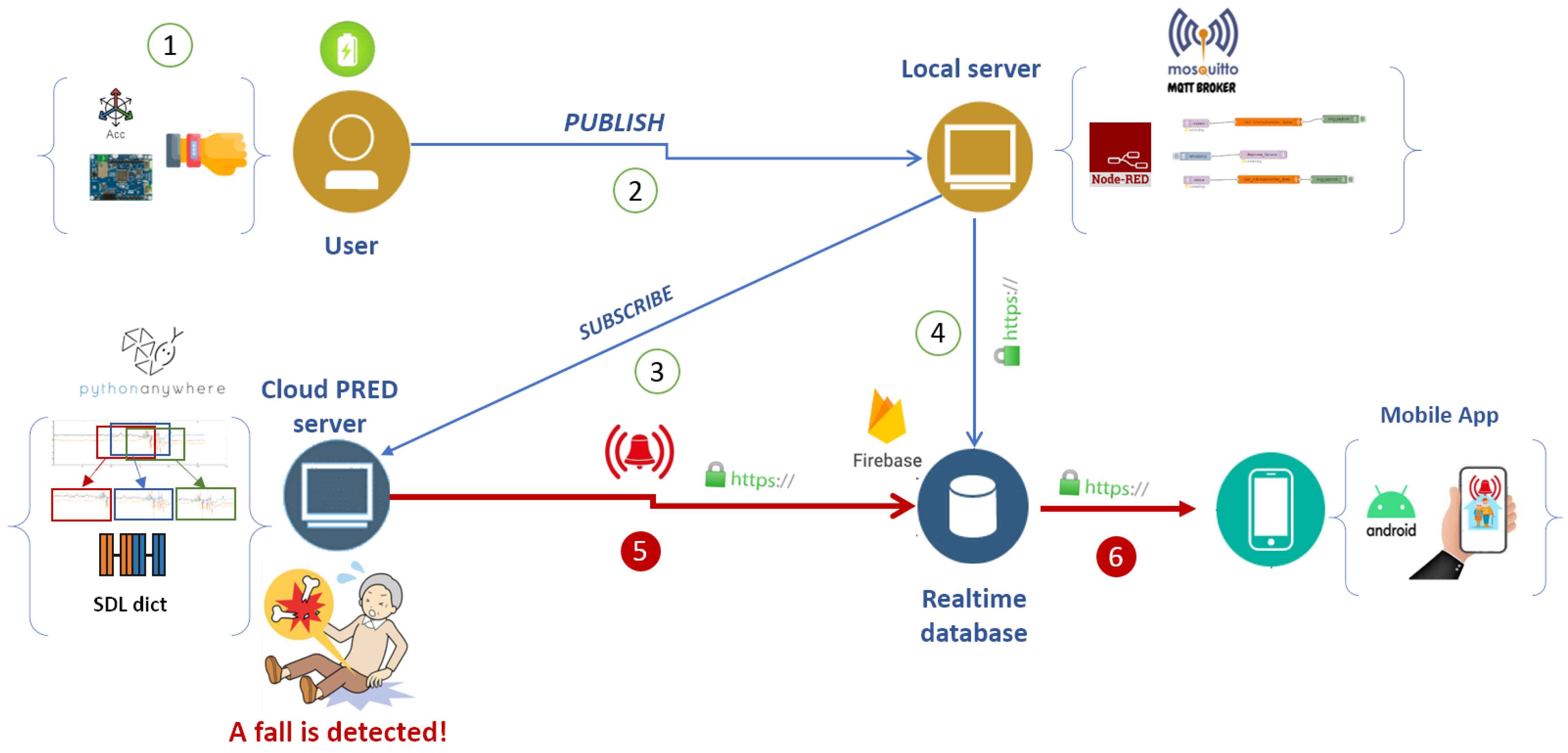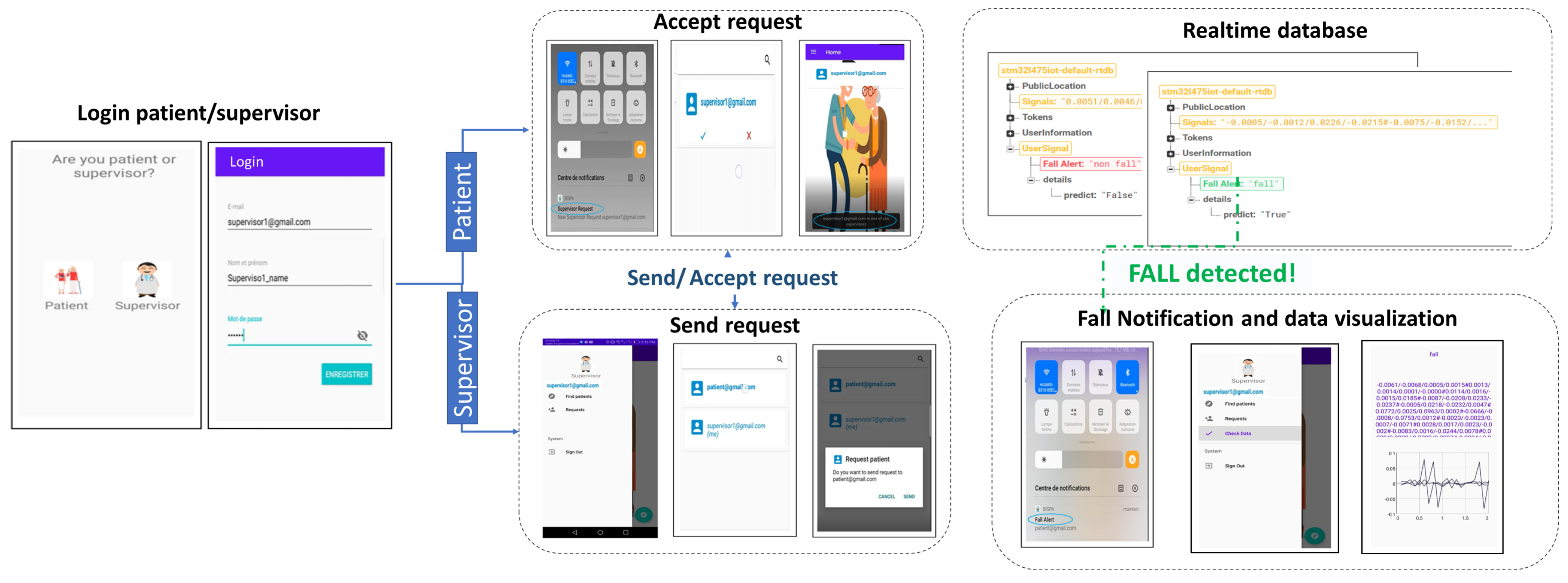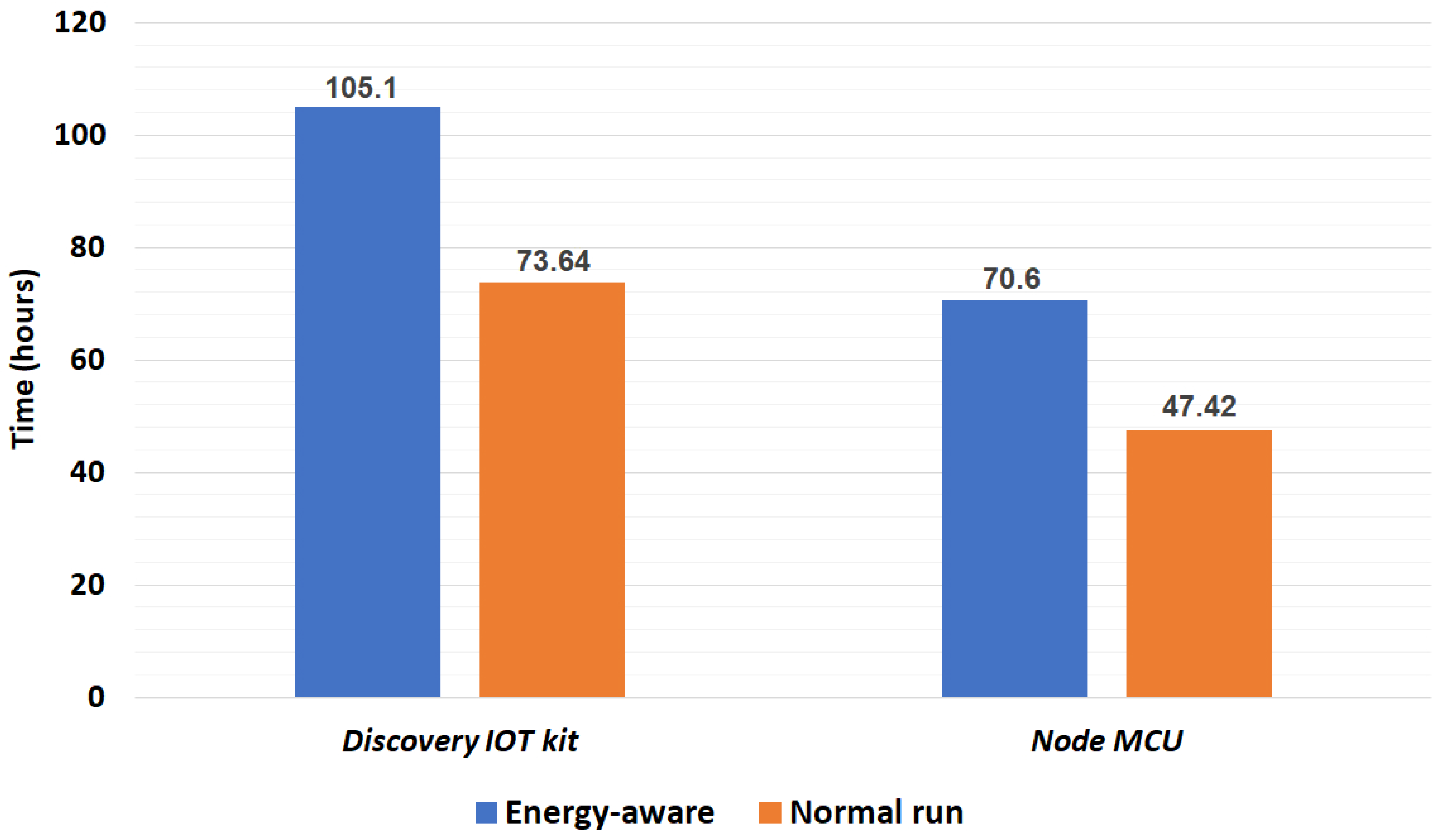Energy-Aware IoT-Based Method for a Hybrid On-Wrist Fall Detection System Using a Supervised Dictionary Learning Technique
Abstract
1. Introduction
1.1. Problem Statement and Assumption
1.2. Contributions
2. Background Scenic Review
2.1. Analysis of Fall Detection Studies
2.1.1. Vision-Based Sensors
2.1.2. Ambient-Based Sensors
2.1.3. Wearable Based Sensors
2.2. Related Works
3. Proposed IoT-Based Framework for Wrist-Based Fall Detection
3.1. Power Management Block (PMB)
3.2. Message Queuing Telemetry Transport Broker (MQTT)
3.3. Sliding Window Block (SWB)
3.4. Prediction Block (PRDB)
| Algorithm 1 Hybrid SDL algorithm for fall detection. |
Input win_data, event_mode, thresh Output Pred_alert
|
4. Evaluation and Results
4.1. Experimentation Setup
4.1.1. Hardware
- Discovery IoT kit: This is a low-power IoT sensor node based on the STM32L4 MCU series. It encompasses multiple wireless connectivity protocols and sensors in which we have enabled the Iventek ISM43362-M3G-L44 Wifi module and LSM6DSL accelerometer node;
- NodeMCU: A miniature IoT firmware based on ESP8266 Wifi module, and we have added an ADXL345 accelerometer sensor.
4.1.2. Software
- PMB: We assume that an inactivity event can be detected after five minutes (inact_dur) of threshold stability of 65.5% (act_inact_thresh). We have limited the FIFO register buffer to 200 samples for each axis (buff_thresh), with a 100 Hz sampling rate;
- SWB: We previously fixed a window size of 4 s, knowing that a fall can take two to three seconds. We assume that, in order to double predict the occurrence of a fall, we have set a FOSW to 75%;
- PRDB: Taking into account the obtained result in our previous work [16,17], the Sparse Representation-based classifier has proved to have a better offline performance and robustness facing noises when trained on multiple situations of the Quadros et al. [11] dataset. Thus, we will be conducting our work to compare the best SDL performance data with our proposed enhanced Algorithm 1 in real-life simulation using a raw accelerometer. In addition, we have fixed a post-fall stability check to the same threshold of the activity/inactivity events for 2 s after the fall.
4.1.3. Evaluation Metrics
4.1.4. Dataset
4.1.5. System Scenario Overview
4.1.6. Deployment
4.1.7. Mobile Application
4.2. Evaluation of Detection Accuracy
4.3. Energy Estimation
4.4. Discussion
5. Conclusions
Author Contributions
Funding
Institutional Review Board Statement
Informed Consent Statement
Data Availability Statement
Conflicts of Interest
References
- U.N. Living arrangements of older persons. In World Population Ageing 2020 Highlights, 2020 ed.; United Nations Department of Economic and Social Affairs, Population Division: New York, NY, USA, 2020; Available online: https://www.un.org/development/desa/pdf/ (accessed on 21 February 2021).
- WHO. External causes of morbidity or mortality. In International Classification of Diseases 11th Revision; World Health Organisation: Geneva, Switzerland, 2021; p. 23. Available online: https://icd.who.int/browse11/l-m/en (accessed on 21 September 2021).
- WHO. WHO Global Report on Falls Prevention in Older Age. In Ageing and Life Course Family and Community Health, 2008 ed.; World Health Organisation: Geneva, Switzerland, 2021; p. 23. [Google Scholar]
- Xu, T.; Zhou, Y.; Zhu, J. New Advances and Challenges of Fall Detection Systems: A Survey. Appl. Sci. 2018, 8, 418. [Google Scholar] [CrossRef]
- Wang, X.; Ellul, J.; Azzopardi, G. Elderly Fall Detection Systems: A Literature Survey. Front. Robot. AI 2020, 7, 71. [Google Scholar] [CrossRef] [PubMed]
- Lee, J.-S.; Tseng, H.-H. Development of an Enhanced Threshold-Based Fall Detection System Using Smartphones with Built-In Accelerometers. IEEE Sens. J. 2019, 19, 8293–8302. [Google Scholar] [CrossRef]
- Ponce, H.; Martínez-Villaseñor, L.; Nuñez-Martínez, J. Sensor Location Analysis and Minimal Deployment for Fall Detection System. IEEE Access 2020, 8, 166678–166691. [Google Scholar] [CrossRef]
- Özdemir, A.T. An Analysis on Sensor Locations of the Human Body for Wearable Fall Detection Devices: Principles and Practice. Sensors 2016, 16, 1161. [Google Scholar] [CrossRef]
- Attaoui, A.E.; Largo, S.; Kaissari, S.; Benba, A.; Jilbab, A.; Bourouhou, A. Machine learning-based edge-computing on a multi-level architecture of WSN and IoT for real-time fall detection. IET Wirel. Sens. Syst. 2020, 10, 320–332. [Google Scholar] [CrossRef]
- Vallabh, P.; Malekian, R.; Ye, N.; Bogatinoska, D.C. Fall detection using machine learning algorithms. In Proceedings of the 2016 24th International Conference on Software, Telecommunications and Computer Networks (SoftCOM), Split, Croatia, 22–24 September 2016; pp. 1–9. [Google Scholar]
- de Quadros, T.; Lazzaretti, A.E.; Schneider, F.K. A Movement Decomposition and Machine Learning-Based Fall Detection System Using Wrist Wearable Device. IEEE Sens. J. 2018, 18, 5082–5089. [Google Scholar] [CrossRef]
- Igual, R.; Medrano, C.; Plaza, I. A comparison of public datasets for acceleration-based fall detection. Med Eng. Phys. 2015, 37, 870–878. [Google Scholar] [CrossRef]
- Aziz, O.; Musngi, M.; Park, E.J.; Mori, G.; Robinovitch, S.N. A comparison of accuracy of fall detection algorithms (threshold-based vs. machine learning) using waist-mounted tri-axial accelerometer signals from a comprehensive set of falls and non-fall trials. Med Biol. Eng. Comput. 2017, 55, 45–55. [Google Scholar] [CrossRef] [PubMed]
- Islam, M.M.; Tayan, O.; Islam, M.R.; Islam, M.S.; Nooruddin, S.; Kabir, M.N.; Islam, M.R. Deep Learning Based Systems Developed for Fall Detection: A Review. IEEE Access 2020, 8, 66117–166137. [Google Scholar] [CrossRef]
- Nho, Y.; Ryu, S.; Kwon, D. UI-GAN: Generative Adversarial Network-Based Anomaly Detection Using User Initial Information for Wearable Devices. IEEE Sens. J. 2021, 21, 9949–9958. [Google Scholar] [CrossRef]
- Othmen, F.; Baklouti, M.; Lazzaretti, A.E.; Jmal, M.; Abid, M. A novel on-wrist fall detection system using Supervised Dictionary Learning technique. In Proceedings of the 18th International Conference On Smart Living and Public Health, Hammamet, Tunisia, 24–27 June 2020. [Google Scholar]
- Othmen, F.; Lazzaretti, A.; Baklouti, M.; Jmal, M.; Abid, M. A Sparse Representation Classification for Noise Robust Wrist-based Fall Detection. In Proceedings of the 14th International Joint Conference on Biomedical Engineering Systems and Technologies–HEALTHINF, Online, 11–13 February 2020; pp. 409–416. [Google Scholar]
- Singh, A.; Rehman, S.U.; Yongchareon, S.; Chong, P.H.J. Sensor Technologies for Fall Detection Systems: A Review. IEEE Sens. J. 2020, 20, 6889–6919. [Google Scholar] [CrossRef]
- Vallabh, P.; Malekian, R. Fall detection monitoring systems: A comprehensive review. J. Ambient. Intell. Humaniz. Comput. 2018, 9, 1809–1833. [Google Scholar] [CrossRef]
- Sabin, B.; Radu, M.; Alexandru, R. Wearable IoT power consumption optimization algorithm. In Proceedings of the 2020 International Conference and Exposition on Electrical In Addition, Power Engineering (EPE), Iaşi, Romania, 22–23 October 2020. [Google Scholar]
- Raval, M.; Bhardwaj, S.; Aravelli, A.; Dofe, J.; Gohel, H. Smart energy optimization for massive IoT using artificial intelligence. IoT 2021, 13, 100354. [Google Scholar] [CrossRef]
- Alrabea, A.; Alzubi, O.A.; Alzubi, J.A. A task-based model for minimizing energy consumption in WSNs. Energy Syst. 2022, 13, 671–688. [Google Scholar] [CrossRef]
- Chéour, R.; Jmal, M.W.; Khriji, S.; Houssaini, D.E.; Trigona, C.; Abid, M.; Kanoun, O. Towards Hybrid Energy-Efficient Power Management in Wireless Sensor Networks. Sensors 2022, 22, 301. [Google Scholar] [CrossRef]
- Qaim, W.B.; Ometov, A.; Lener, I.; Campolo, C.; Lohan, E.S.; Nurmi, J. Towards Energy Efficiency in the Internet of Wearable Things: A Systematic Review. IEEE Access 2020, 8, 175412–175435. [Google Scholar] [CrossRef]
- Benhamaid, S.; Bouabdallah, A.; Lakhlef, H. Recent advances in energy management for Green-IoT: An up-to-date and comprehensive survey. J. Netw. Comput. Appl. 2022, 198, 103257. [Google Scholar] [CrossRef]
- Mauldin, T.R.; Canby, M.E.; Metsis, V.; Ngu, A.H.H.; Rivera, C.C. SmartFall: A Smartwatch-Based Fall Detection System Using Deep Learning. Sensors 2018, 18, 3363. [Google Scholar] [CrossRef] [PubMed]
- Ajerla, D.; Mahfuz, S.; Zulkernine, F. A Real-Time Patient Monitoring Framework for Fall Detection. Wirel. Commun. Mob. Comput. 2019, 2019, 9507938. [Google Scholar] [CrossRef]
- Gia, T.N.; Sarker, V.K.; Tcarenko, I.; Rahmani, A.M.; Westerlund, T.; Liljeberg, P.; Tenhunen, H. Energy efficient wearable sensor node for IoT-based fall detection systems. Microprocess. Microsyst. 2018, 56, 34–46. [Google Scholar]
- Liu, L.; Hou, Y.; He, J.; Lungu, J.; Dong, R. An Energy-Efficient Fall Detection Method Based on FD-DNN for Elderly People. Sensors 2020, 20, 419. [Google Scholar] [CrossRef] [PubMed]
- Saadeh, W.; Butt, S.A.; Altaf, M.A.B. A Patient-Specific Single Sensor IoT-Based Wearable Fall Prediction and Detection System. IEEE Trans. Neural Syst. Rehabil. Eng. 2019, 27, 995–1003. [Google Scholar] [CrossRef]
- Putra, I.P.E.S.; Vesilo, R. Window-size impact on detection rate of wearable-sensor-based fall detection using supervised machine learning. In Proceedings of the 2017 IEEE Life Sciences Conference (LSC), Sydney, Australia, 13–15 December 2017; pp. 21–26. [Google Scholar]
- Suo, Y.; Dao, M.; Srinivas, U.; Monga, V.; Tran, T.D. Structured Dictionary Learning for Classification. arXiv 2014, arXiv:1406.1943. [Google Scholar]
- Gangeh, M.J.; Farahat, A.K.; Ghodsi, A.; Kamel, M.S. Supervised Dictionary Learning and Sparse Representation-A Review. arXiv 2015, arXiv:1502.05928. [Google Scholar]
- Wright, J.; Yang, A.Y.; Ganesh, A.; Sastry, S.S.; Ma, Y. Robust Face Recognition via Sparse Representation. IEEE Trans. Pattern Anal. Mach. Intell. 2009, 31, 210–227. [Google Scholar] [CrossRef]
- Vu, T.H.; Monga, V. Learning a low-rank shared dictionary for object classification. In Proceedings of the 2016 International Conference on Image Processing (ICIP), Phoenix, AZ, USA, 25–28 September 2016; pp. 4428–4432. [Google Scholar]
- Vu, T.H.; Monga, V. Fast low-rank shared dictionary learning for image classification. IEEE Trans. Image Process. 2017, 26, 5160–5175. [Google Scholar] [CrossRef]
- Yang, M.; Zhang, L.; Feng, X.; Zhang, D. Fisher Discrimination Dictionary Learning for sparse representation. In Proceedings of the 2011 International Conference on Computer Vision, Barcelona, Spain, 6–13 November 2011; pp. 543–550. [Google Scholar]
- Stephen, N. Power Profiling: HTTPS Long Polling vs. MQTT with SSL, on Android, May 2012. Available online: http://stephendnicholas.com/archives/1217 (accessed on 23 February 2021).






| SDL Algorithm | SRC | FDDL | LRSDL |
|---|---|---|---|
| AC (%) | 99.8 | 98.9 | 97.4 |
| SE (%) | 100 | 98.9 | 97.9 |
| SP (%) | 99.6 | 98.9 | 96.9 |
| Simulation | SDL | Hybrid SDL | ||
|---|---|---|---|---|
| Fall | ADL | Fall | ADL | |
| Falling | 100 | 0 | 100 | 0 |
| Jumping | 60 | 40 | 20 | 80 |
| Raising and releasing hand | 70 | 30 | 20 | 80 |
| Clapping | 40 | 60 | 0 | 100 |
| Walking | 0 | 100 | 0 | 100 |
| Going Upstairs | 30 | 70 | 10 | 90 |
| Going Downstairs | 50 | 50 | 15 | 85 |
| Components | Running Mode | Idle/Sleep Mode | E (mJ) | ||
|---|---|---|---|---|---|
| I (mA) | V (v) | I (mA) | V (v) | ||
| STM32L4 MCU (16 MHz) | 1.6 | 3.6 | 0.56 | 3.6 | 40.063 |
| LSM6DSL (SR: 100 Hz) | 0.085 | 3.3 | 0.003 | 3.3 | |
| ISM43362-M3G-L44 (WIFI) | 50 | 3.3 | 4.7 | 3.3 | |
| NodeMCU (ESP8266EX ) | 80 | 3.3 | 0.9 | 3.3 | 159.893 |
| ADXL345 (SR: 100 Hz) | 0.13 | 3.3 | 0.037 | 3.3 | |
| Feature | [26] | [27] | [28] | [29] | [30] | Our Work |
|---|---|---|---|---|---|---|
| Detection Approach | RNN | LSTM | Threshold comparison | Convolution, Max-pooling and LSTM | Nonlinear SVM/Threshold | Hybrid SDL and Threshold |
| Used Sensors | Accelerometer | Accelerometer | Accelerometer and gyroscope | Accelerometer and gyroscope | Accelerometer | Accelerometer |
| Placement | Wrist | Wrist | Chest | Front waist | Thigh | Wrist |
| Sampling rate (Hz) | 32.25 | 50 | 50 | 100 | 256 | 100 |
| Gateway dependent | Yes via BLE | Yes via BLE | Yes via nRF | Yes via zigbee | Yes via BLE | No via MQTT |
| Energy aware | Low sampling rate (32.25 Hz) | 50 Hz sampling rate | 50 Hz sampling rate, SPI com bus | Interruption trigger (Free fall and FIFO) | NA | Interruption trigger (Activity/Inactivity and FIFO) |
| Performance (%) | Offline: AC = 99 Online: AC = 70 | Offline: AC = 99.6 Online: AC = 85.2 | NA | Offline: AC = 99.17, SP = 99.94 Online: AC = 98.25, SP = 87.72 | Offline: SE = 98.6 SP = 99.3 Online: NA | Offline AC = 99.8, SP = 99.6 Online: AC = 91, SP = 89.2 |
| Autonomy (Hours)/battery (mAH) | NA | NA | 76/1000 Continuous run | 140/600 active 8 h per day | NA | 115/3800 active 16 h per day |
Disclaimer/Publisher’s Note: The statements, opinions and data contained in all publications are solely those of the individual author(s) and contributor(s) and not of MDPI and/or the editor(s). MDPI and/or the editor(s) disclaim responsibility for any injury to people or property resulting from any ideas, methods, instructions or products referred to in the content. |
© 2023 by the authors. Licensee MDPI, Basel, Switzerland. This article is an open access article distributed under the terms and conditions of the Creative Commons Attribution (CC BY) license (https://creativecommons.org/licenses/by/4.0/).
Share and Cite
Othmen, F.; Baklouti, M.; Lazzaretti, A.E.; Hamdi, M. Energy-Aware IoT-Based Method for a Hybrid On-Wrist Fall Detection System Using a Supervised Dictionary Learning Technique. Sensors 2023, 23, 3567. https://doi.org/10.3390/s23073567
Othmen F, Baklouti M, Lazzaretti AE, Hamdi M. Energy-Aware IoT-Based Method for a Hybrid On-Wrist Fall Detection System Using a Supervised Dictionary Learning Technique. Sensors. 2023; 23(7):3567. https://doi.org/10.3390/s23073567
Chicago/Turabian StyleOthmen, Farah, Mouna Baklouti, André Eugenio Lazzaretti, and Monia Hamdi. 2023. "Energy-Aware IoT-Based Method for a Hybrid On-Wrist Fall Detection System Using a Supervised Dictionary Learning Technique" Sensors 23, no. 7: 3567. https://doi.org/10.3390/s23073567
APA StyleOthmen, F., Baklouti, M., Lazzaretti, A. E., & Hamdi, M. (2023). Energy-Aware IoT-Based Method for a Hybrid On-Wrist Fall Detection System Using a Supervised Dictionary Learning Technique. Sensors, 23(7), 3567. https://doi.org/10.3390/s23073567







